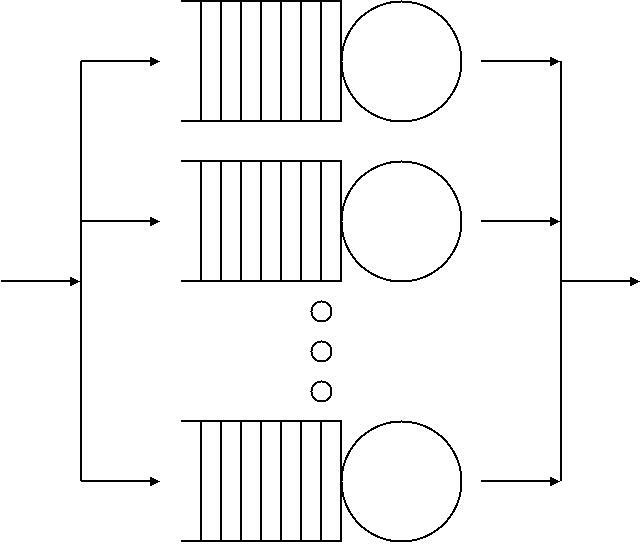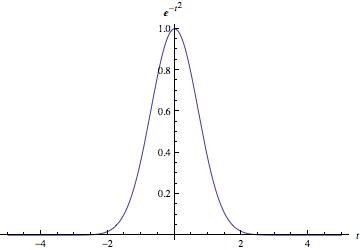|
Mean Value Analysis
In queueing theory, a discipline within the mathematical theory of probability, mean value analysis (MVA) is a recursive technique for computing expected queue lengths, waiting time at queueing nodes and throughput in equilibrium for a closed separable system of queues. The first approximate techniques were published independently by Schweitzer and Bard, followed later by an exact version by Lavenberg and Reiser published in 1980. It is based on the arrival theorem, which states that when one customer in an ''M''-customer closed system arrives at a service facility he/she observes the rest of the system to be in the equilibrium state for a system with ''M'' − 1 customers. Problem setup Consider a closed queueing network of ''K'' M/M/1 queues, with ''M'' customers circulating in the system. Suppose that the customers are indistinguishable from each other, so that the network has a single class of customers. To compute the mean queue length and waiting time at each o ... [...More Info...] [...Related Items...] OR: [Wikipedia] [Google] [Baidu] |
Queueing Theory
Queueing theory is the mathematical study of waiting lines, or queues. A queueing model is constructed so that queue lengths and waiting time can be predicted. Queueing theory is generally considered a branch of operations research because the results are often used when making business decisions about the resources needed to provide a service. Queueing theory has its origins in research by Agner Krarup Erlang, who created models to describe the system of incoming calls at the Copenhagen Telephone Exchange Company. These ideas were seminal to the field of teletraffic engineering and have since seen applications in telecommunications, traffic engineering, computing, project management, and particularly industrial engineering, where they are applied in the design of factories, shops, offices, and hospitals. Spelling The spelling "queueing" over "queuing" is typically encountered in the academic research field. In fact, one of the flagship journals of the field is '' Queue ... [...More Info...] [...Related Items...] OR: [Wikipedia] [Google] [Baidu] |
GNU Octave
GNU Octave is a scientific programming language for scientific computing and numerical computation. Octave helps in solving linear and nonlinear problems numerically, and for performing other numerical experiments using a language that is mostly compatible with MATLAB. It may also be used as a Batch processing, batch-oriented language. As part of the GNU Project, it is free software under the terms of the GNU General Public License. History The project was conceived around 1988. At first it was intended to be a companion to a chemical reactor design course. Full development was started by John W. Eaton in 1992. The first alpha release dates back to 4 January 1993 and on 17 February 1994 version 1.0 was released. Version 9.2.0 was released on 7 June 2024. The program is named after Octave Levenspiel, a former professor of the principal author. Levenspiel was known for his ability to perform quick back-of-the-envelope calculations. Development history Developments In addition ... [...More Info...] [...Related Items...] OR: [Wikipedia] [Google] [Baidu] |
Java (programming Language)
Java is a High-level programming language, high-level, General-purpose programming language, general-purpose, Memory safety, memory-safe, object-oriented programming, object-oriented programming language. It is intended to let programmers ''write once, run anywhere'' (Write once, run anywhere, WORA), meaning that compiler, compiled Java code can run on all platforms that support Java without the need to recompile. Java applications are typically compiled to Java bytecode, bytecode that can run on any Java virtual machine (JVM) regardless of the underlying computer architecture. The syntax (programming languages), syntax of Java is similar to C (programming language), C and C++, but has fewer low-level programming language, low-level facilities than either of them. The Java runtime provides dynamic capabilities (such as Reflective programming, reflection and runtime code modification) that are typically not available in traditional compiled languages. Java gained popularity sh ... [...More Info...] [...Related Items...] OR: [Wikipedia] [Google] [Baidu] |
The Computer Journal
''The Computer Journal'' is a peer-reviewed scientific journal covering computer science and information systems. Established in 1958, it is one of the oldest computer science research journals. It is published by Oxford University Press on behalf of BCS, The Chartered Institute for IT. The authors of the best paper in each annual volume receive the Wilkes Award from BCS, The Chartered Institute for IT. Editors-in-chief The following people have been editor-in-chief An editor-in-chief (EIC), also known as lead editor or chief editor, is a publication's editorial leader who has final responsibility for its operations and policies. The editor-in-chief heads all departments of the organization and is held accoun ...: * 1958–1969 Eric N. Mutch * 1969–1992 Peter Hammersley * 1993–2000 C. J. van Rijsbergen * 2000–2008 Fionn Murtagh * 2008–2012 Erol Gelenbe * 2012–2016 Fionn Murtagh * 2016–2020 Steve Furber * 2021–present Tom Crick References External links Of ... [...More Info...] [...Related Items...] OR: [Wikipedia] [Google] [Baidu] |
Key Distribution Center
In cryptography, a key distribution center (KDC) is part of a cryptosystem intended to reduce the risks inherent in exchanging keys. KDCs often operate in systems within which some users may have permission to use certain services at some times and not at others. Security overview For instance, an administrator may have established a policy that only certain users may back up to tape. Many operating system An operating system (OS) is system software that manages computer hardware and software resources, and provides common daemon (computing), services for computer programs. Time-sharing operating systems scheduler (computing), schedule tasks for ...s can control access to the tape facility via a "system service". If that system service further restricts the tape drive to operate only on behalf of users who can submit a service-granting ticket when they wish to use it, there remains only the task of distributing such tickets to the appropriately permitted users. If the tick ... [...More Info...] [...Related Items...] OR: [Wikipedia] [Google] [Baidu] |
Queueing Network
Queueing theory is the mathematical study of waiting lines, or queues. A queueing model is constructed so that queue lengths and waiting time can be predicted. Queueing theory is generally considered a branch of operations research because the results are often used when making business decisions about the resources needed to provide a service. Queueing theory has its origins in research by Agner Krarup Erlang, who created models to describe the system of incoming calls at the Copenhagen Telephone Exchange Company. These ideas were seminal to the field of teletraffic engineering and have since seen applications in telecommunications, traffic engineering, computing, project management, and particularly industrial engineering, where they are applied in the design of factories, shops, offices, and hospitals. Spelling The spelling "queueing" over "queuing" is typically encountered in the academic research field. In fact, one of the flagship journals of the field is ''Queueing ... [...More Info...] [...Related Items...] OR: [Wikipedia] [Google] [Baidu] |
PEPA
Performance Evaluation Process Algebra (PEPA) is a stochastic process algebra designed for modelling computer and communication systems introduced by Jane Hillston in the 1990s. The language extends classical process algebras such as Milner's CCS and Hoare's CSP by introducing probabilistic branching and timing of transitions. Rates are drawn from the exponential distribution and PEPA models are finite-state and so give rise to a stochastic process In probability theory and related fields, a stochastic () or random process is a mathematical object usually defined as a family of random variables in a probability space, where the index of the family often has the interpretation of time. Sto ..., specifically a continuous-time Markov process (CTMC). Thus the language can be used to study quantitative properties of models of computer and communication systems such as throughput, utilisation and Response time (technology), response time as well as qualitative properties such ... [...More Info...] [...Related Items...] OR: [Wikipedia] [Google] [Baidu] |
BCMP Network
In queueing theory, a discipline within the mathematical theory of probability, a BCMP network is a class of queueing network for which a product-form equilibrium distribution exists. It is named after the authors of the paper where the network was first described: Baskett, Chandy, Muntz, and Palacios. The theorem is a significant extension to a Jackson network allowing virtually arbitrary customer routing and service time distributions, subject to particular service disciplines. The paper is well known, and the theorem was described in 1990 as "one of the seminal achievements in queueing theory in the last 20 years" by J. Michael Harrison and Ruth J. Williams. Definition of a BCMP network A network of ''m'' interconnected queues is known as a BCMP network if each of the queues is of one of the following four types: # FCFS discipline where all customers have the same negative exponential service time distribution. The service rate can be state dependent, so write \scriptsty ... [...More Info...] [...Related Items...] OR: [Wikipedia] [Google] [Baidu] |
Theory Of Probability
Probability theory or probability calculus is the branch of mathematics concerned with probability. Although there are several different probability interpretations, probability theory treats the concept in a rigorous mathematical manner by expressing it through a set of axioms of probability, axioms. Typically these axioms formalise probability in terms of a probability space, which assigns a measure (mathematics), measure taking values between 0 and 1, termed the probability measure, to a set of outcomes called the sample space. Any specified subset of the sample space is called an event (probability theory), event. Central subjects in probability theory include discrete and continuous random variables, probability distributions, and stochastic processes (which provide mathematical abstractions of determinism, non-deterministic or uncertain processes or measured Quantity, quantities that may either be single occurrences or evolve over time in a random fashion). Although it is no ... [...More Info...] [...Related Items...] OR: [Wikipedia] [Google] [Baidu] |
Fixed-point Iteration
In numerical analysis, fixed-point iteration is a method of computing fixed points of a function. More specifically, given a function f defined on the real numbers with real values and given a point x_0 in the domain of f, the fixed-point iteration is x_=f(x_n), \, n=0, 1, 2, \dots which gives rise to the sequence x_0, x_1, x_2, \dots of iterated function applications x_0, f(x_0), f(f(x_0)), \dots which is hoped to converge to a point x_\text. If f is continuous, then one can prove that the obtained x_\text is a fixed point of f, i.e., f(x_\text)=x_\text . More generally, the function f can be defined on any metric space with values in that same space. Examples * A first simple and useful example is the Babylonian method for computing the square root of , which consists in taking f(x) = \frac 1 2 \left(\frac a x + x\right), i.e. the mean value of and , to approach the limit x = \sqrt a (from whatever starting point x_0 \gg 0 ). This is a special case of Newton's method quo ... [...More Info...] [...Related Items...] OR: [Wikipedia] [Google] [Baidu] |



